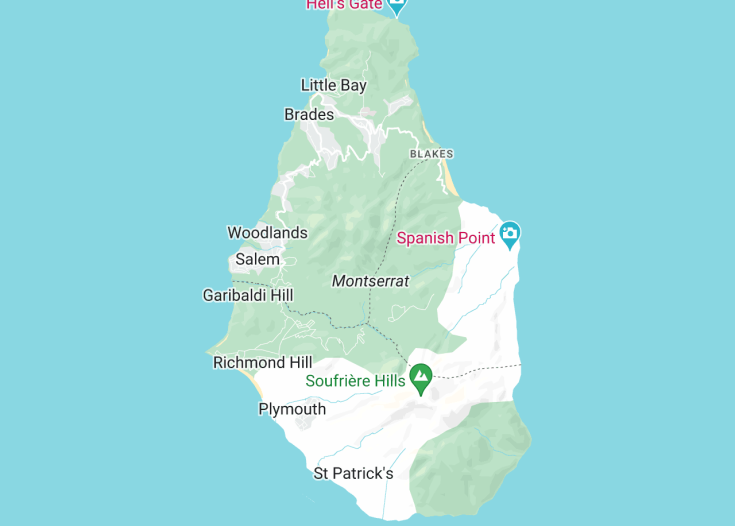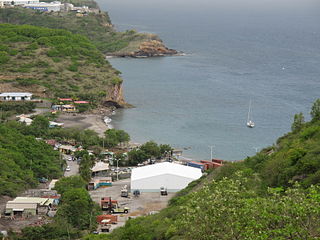Montserrat, the “Emerald Isle of the Caribbean”, beckons with its verdant landscapes, volcanic vistas, and rich Irish heritage. This British Overseas Territory has rebounded from volcanic eruptions, now offering visitors a unique blend of untouched nature and resilient culture. Experience the charm of its quiet villages, witness the dramatic contrast of the Exclusion Zone, and immerse yourself in the island’s inviting rhythms. Beyond the natural allure, Montserrat’s warmth is palpable, encapsulated by its friendly locals and melodious calypso tunes.
Travel during St. Patrick’s Festival in March to experience Montserrat’s unique blend of Caribbean and Irish festivities.
Ensure you take a guided tour of the Exclusion Zone for an insightful look at the island’s transformative history.
Montserrat: The emerald isle of the Caribbean
| Capital | Plymouth (official, but abandoned due to volcanic activity), Brades (de facto) |
| Time in Montserrat | GMT-4 |
| Language spoken | English |
| Population | Approximately 4,900 (Source: United Nations, 2022) |
| Religion | Christian (Protestant) (67%) Christian (Roman Catholic) (23%) Other Religions (5%) Unaffiliated (5%) |
| Currency | East Caribbean Dollar (XCD, $) |
| Airports | John A. Osborne Airport |
The Caribbean island of Montserrat holds a unique charm that captivates its visitors. This British Overseas Territory, with its lush landscapes and verdant hills, offers an idyllic escape from the bustle of modern life.
One of the most significant episodes in Montserrat’s history was the eruption of the Soufrière Hills volcano in 1997. This cataclysmic event dramatically transformed the island’s topography and caused the capital, Plymouth, to be buried under ash and mud. Today, the modern-day Pompeii stands as a haunting testament to nature’s fury, with its abandoned buildings providing a poignant backdrop for tourists. The Exclusion Zone, which encompasses Plymouth, offers guided tours allowing visitors to witness the remnants of a once-thriving city now silenced by volcanic ash.
Yet, Montserrat’s allure is not solely rooted in its dramatic past. The island is a sanctuary for nature lovers. Hiking trails wind through dense forests, revealing hidden waterfalls and offering panoramic views of the shimmering Caribbean Sea. Its shores, fringed with black and golden sand beaches, invite relaxation and provide opportunities for diving and snorkeling in crystal-clear waters.
Moreover, Montserrat’s rich Irish heritage, stemming from early Irish settlers, sets it apart from other Caribbean islands. This legacy is celebrated annually during St. Patrick’s Day, a week-long festivity that blends Caribbean and Irish traditions in a vibrant display of cultural fusion.
Where is Montserrat located?
Montserrat is situated in the Lesser Antilles of the Caribbean, southeast of Puerto Rico and northwest of Guadeloupe.
What is Montserrat famous for?
Montserrat is renowned for its Soufrière Hills volcano, the abandoned capital of Plymouth, its unique blend of Caribbean and Irish heritage, and its pristine natural landscapes including black sand beaches and lush greenery.
History
Pre-European Contact: Indigenous Peoples
Before the arrival of Europeans, Montserrat was inhabited by indigenous Arawak and Carib peoples. They named the island “Alliouagana”, which means “Land of the Prickly Bush”. The Arawaks were the earlier settlers, while the more aggressive Caribs arrived later and established dominance over the island.
1493–1632: European Discovery and Early Settlements
Montserrat was discovered by Christopher Columbus during his second voyage in 1493. He named it Montserrat after the mountain range in Spain due to its rugged and mountainous appearance. Over the following century, while various European powers showed interest, none established a lasting settlement due to stiff resistance from the Caribs.
1632–1782: British Colonization and Sugar Boom
The British established a successful colony in 1632, initially populated by Irish settlers sent by the British from neighboring islands. These early European settlers established tobacco and indigo plantations. By the late 17th century, with the introduction of sugarcane, Montserrat underwent an economic transformation. Plantations proliferated, and with them came the brutal system of African slavery. The island became a key player in the Caribbean sugar economy.
1782–1860: Conflicts and Emancipation
During the 18th century, the Caribbean islands, including Montserrat, were frequently contested between the British and French colonial powers. The island changed hands several times but was ultimately returned to the British under the Treaty of Paris in 1783. In 1834, the Slavery Abolition Act was passed by the British Parliament, leading to the emancipation of slaves in Montserrat. The subsequent years saw struggles for labor rights and land ownership.
1860–1960: Economic Struggles and Dependency
Post-emancipation, Montserrat’s sugar industry gradually declined due to global market forces and natural disasters. By the early 20th century, the island’s economy shifted towards lime production and sea-island cotton. Yet, these sectors too struggled to maintain profitability. The decline in traditional industries left Montserrat heavily reliant on British financial aid.
1960–1995: Towards Modernity and Political Evolution
In 1967, Montserrat opted to become a Crown Colony, thereby relinquishing its colonial status and achieving greater self-governance. During the 1970s and 1980s, the island saw development in tourism and offshore banking, diversifying its economy. However, its political journey towards decolonization and increased autonomy remained a key debate.
1995–Present: Volcanic Crisis and Resilience
In 1995, the Soufrière Hills volcano, dormant for centuries, erupted and rendered more than half of Montserrat uninhabitable. The capital, Plymouth, was buried under volcanic debris, and many residents were evacuated. The eruptions profoundly impacted the island’s economy and demography. However, with international aid and the resilience of its people, Montserrat has embarked on a path of recovery and reconstruction. Today, the island is rebuilding, with an emphasis on sustainable development and eco-tourism.
Visit Montserrat
What to see and do in Montserrat
Montserrat offers visitors a unique blend of natural beauty, cultural heritage, and adventure. Here are some of the top attractions and activities to explore:
- Explore the Montserrat Volcano Observatory to gain insight into the island’s volcanic activity.
- Hike through the lush rainforest trails of the Centre Hills, home to diverse plant and animal species.
- Visit the Montserrat National Trust to learn about the island’s history, culture, and conservation efforts.
- Take a boat tour around the coastline to admire the stunning cliffs and hidden coves.
- Relax on one of the island’s picturesque beaches, such as Rendezvous Bay or Little Bay.
- Experience the vibrant local music scene by attending a calypso or reggae concert.
- Sample traditional Montserratian cuisine, including goat water stew and seafood dishes.
Events in Montserrat
Montserrat hosts several annual events that showcase its rich culture and traditions. The most famous event is the St. Patrick’s Festival, held in March to celebrate the island’s Irish heritage. The festival features lively parades, music performances, traditional dancing, and a spectacular fireworks display. Other events include the Alliouagana Festival of the Word, which focuses on literature and storytelling, and the Magma Festival, which showcases local music, arts, and crafts. These events typically take place during the island’s dry season, between December and May, when the weather is most favorable.
Best time to visit Montserrat
The best time to visit Montserrat is during the dry season, which runs from December to April. This period offers pleasant weather with lower chances of rain, allowing visitors to fully enjoy outdoor activities and explore the island’s natural attractions. It is also the festive season when various cultural events and festivals take place, adding to the vibrant atmosphere. However, it’s important to note that Montserrat is a volcanic island, and volcanic activity can impact travel plans and access to certain areas. Therefore, it is advisable to check the latest updates and guidelines from the local authorities before planning a trip.
Is Montserrat worth visiting?
Montserrat is definitely worth visiting for those seeking a unique Caribbean experience. The island’s rich history, stunning natural landscapes, and vibrant cultural scene offer intriguing aspects to explore. The blend of Irish and Caribbean influences creates a distinctive atmosphere that sets Montserrat apart from other destinations. However, it’s crucial to consider the impact of the volcanic activity on the island. The Soufrière Hills volcano continues to be monitored, and certain areas may be restricted due to safety concerns. Travelers should stay informed about any volcanic updates and carefully plan their visit accordingly. Overall, Montserrat holds a charm that appeals to adventurers, nature enthusiasts, and those interested in cultural heritage.
Common questions
What are the must-see attractions in Montserrat?
- The Montserrat Monastery: This Benedictine abbey is a significant religious site and offers stunning views of the surrounding countryside.
- The Sant Joan Funicular: Take a ride on this funicular railway to reach the top of Montserrat Mountain, where you can enjoy breathtaking views.
- The Black Madonna: Visit the Basilica of Montserrat to see the famous statue of the Black Madonna, a revered religious symbol.
- The Museum of Montserrat: Explore the museum to learn more about the history, art, and culture of Montserrat and its monastery.
- The Montserrat Natural Park: Immerse yourself in nature by hiking through the beautiful trails of this natural park.
What is the best time to visit Montserrat?
What is the best way to reach Montserrat?
- Take the Sant Joan Funicular: This funicular railway will take you up to the top of Montserrat Mountain.
- Take the Cable Car: The Aeri de Montserrat cable car offers a scenic ride up the mountain, providing spectacular views along the way.
Both options provide convenient transportation to Montserrat, and the choice between them depends on your preference for the type of experience you desire.
Are there any hiking trails in Montserrat?
- Santa Cova Trail: This easy trail takes you on a scenic walk through the woods and leads to the Santa Cova Chapel.
- Montserrat Summit Trail: This moderate trail leads to the summit of Montserrat Mountain, offering breathtaking views along the way.
- La Foradada Trail: This challenging trail takes you to a stunning viewpoint with a natural rock formation known as “La Foradada.”
These trails provide an opportunity to explore the natural beauty of Montserrat and enjoy the serenity of the surrounding landscape.
Can you recommend any restaurants near Montserrat?
- Restaurant Abat Cisneros: This restaurant is located within the Montserrat Monastery and offers traditional Catalan cuisine in a beautiful setting.
- Restaurant Rincón de L’Artista: Situated in the town of Monistrol de Montserrat, this restaurant specializes in local dishes and boasts panoramic views of the mountain.
- Can Xitrus: Located in Collbató, this restaurant is known for its delicious Mediterranean cuisine and charming atmosphere.
These restaurants provide an opportunity to indulge in delightful meals while enjoying the scenery and ambiance of the Montserrat region.
Are there any hotels or accommodations in Montserrat?
What activities are available for children in Montserrat?
- The Sant Joan Funicular: Children will enjoy the ride on the funicular as it climbs up the mountain, providing exciting views and a memorable experience.
- Nature Walks: Montserrat has various walking trails suitable for children, allowing them to explore the natural beauty of the area while enjoying a family-friendly hike.
- The Museum of Montserrat: The museum offers interactive exhibits, artwork, and artifacts that can educate and engage children in learning about the history and culture of Montserrat.
These activities provide an enjoyable and educational experience for children visiting Montserrat.
Is it possible to visit Montserrat on a day trip from Barcelona?
Can I take a guided tour of Montserrat?
What is the significance of the Black Madonna statue in Montserrat?
Can I attend a performance by the Montserrat Boys Choir?
What are some traditional Catalan dishes I can try in Montserrat?
- Pa amb tomàquet: This simple yet delicious dish consists of bread rubbed with tomato, drizzled with olive oil, and seasoned with salt.
- Escudella i carn d’olla: A hearty Catalan stew that typically includes a variety of meats, vegetables, and legumes.
- Coca de recapte: A traditional pastry topped with roasted vegetables, anchovies, and other savory toppings.
These dishes showcase the flavors and culinary traditions of Catalonia and provide a delightful gastronomic experience in Montserrat.













